fuel Acura TSX 2012 Owner's Guide
[x] Cancel search | Manufacturer: ACURA, Model Year: 2012, Model line: TSX, Model: Acura TSX 2012Pages: 324, PDF Size: 9.45 MB
Page 228 of 324
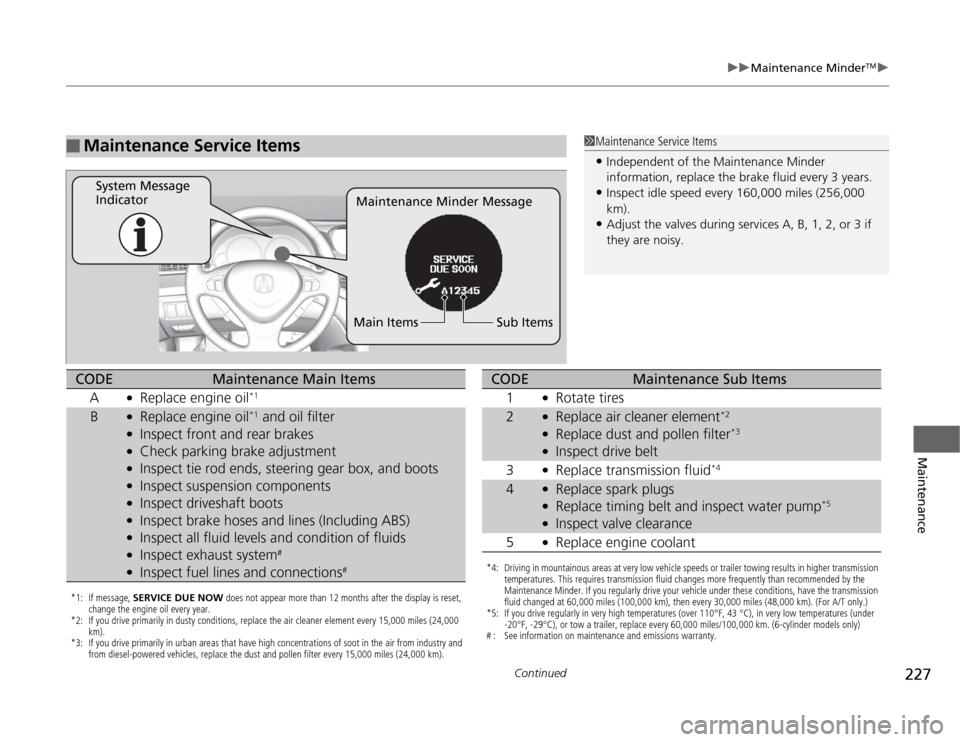
227
uuMaintenance Minder
TMu
Continued
Maintenance
■
Maintenance Service Items
1Maintenance Service Items•Independent of the Maintenance Minder
information, replace the brake fluid every 3 years.•Inspect idle speed every 160,000 miles (256,000
km).•Adjust the valves during services A, B, 1, 2, or 3 if
they are noisy.
Maintenance Minder Message System Message
Indicator
Sub Items Main Items
*1: If message, SERVICE DUE NOW does not appear more than 12 months after the display is reset,
change the engine oil every year.
*2: If you drive primarily in dusty conditions, replace the air cleaner element every 15,000 miles (24,000
km).
*3: If you drive primarily in urban areas that have high concentrations of soot in the air from industry and
from diesel-
powered vehicles, re
place the dust and
pollen filter ever
y 15,000 miles (24,000 km).
CODE
Maintenance Main Items
A
●
Replace engine oil
*1
B
●
Replace engine oil
*1 and oil filter
●
Inspect front and rear brakes
●
Check parking brake adjustment
●
Inspect tie rod ends, steering gear box, and boots
●
Inspect suspension components
●
Inspect driveshaft boots
●
Inspect brake hoses and lines (Including ABS)
●
Inspect all fluid levels and condition of fluids
●
Inspect exhaust system
#
●
Inspect fuel lines and connections
#
*4: Driving in mountainous areas at very low vehicle speeds or trailer towing results in higher transmission
temperatures. This requires transmission fluid changes more frequently than recommended by the
Maintenance Minder. If you regularly drive your vehicle under these conditions, have the transmission
fluid changed at 60,000 miles (100,000 km), then every 30,000 miles (48,000 km). (For A/T only.)
*5: If you drive regularly in very high temperatures (over 110°F, 43 °C), in very low temperatures (under
-20°F, -29°C), or tow a trailer, replace every 60,000 miles/100,000 km. (6-cylinder models only)
# : See information on maintenance and emissions warranty.CODE
Maintenance Sub Items
1
●
Rotate tires
2
●
Replace air cleaner element
*2
●
Replace dust and pollen filter
*3
●
Inspect drive belt
3
●
Replace transmission fluid
*4
4
●
Replace spark plugs
●
Replace timing belt and inspect water pump
*5
●
Inspect valve clearance
5
●
Replace engine coolant
Page 236 of 324

235
uuMaintenance Under the HooduOil Check
Continued
Maintenance
Oil CheckWe recommend that you check the engine oil level every time you refuel.
Park the vehicle on level ground.
Wait approximately three minutes after turning the engine off before you check the
oil.
1.Remove the dipstick (orange handle).
1.Remove the dipstick (orange loop).
2.Wipe the dipstick with a clean cloth or
paper towel.
3.Insert the dipstick back all the way into its
hole.
1Oil Check
If the oil level is near or below the lower mark, slowly
add oil being careful not to overfill.
6-cylinder models4-cylinder models
4-cylinder models6-cylinder modelsAll models
Page 241 of 324
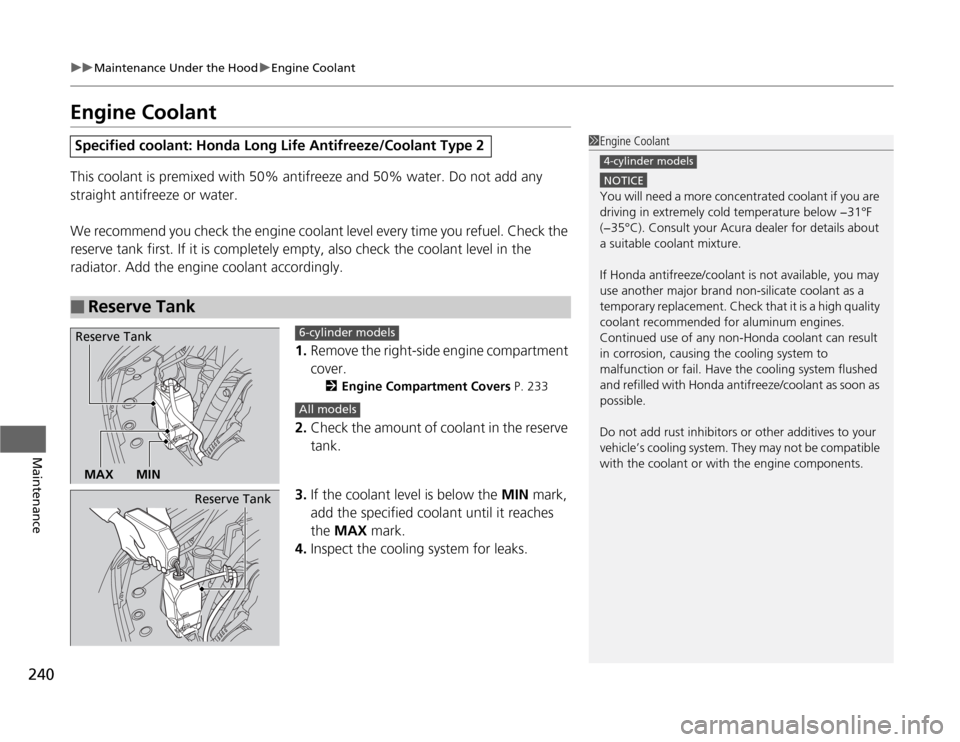
240
uuMaintenance Under the HooduEngine Coolant
Maintenance
Engine CoolantThis coolant is premixed with 50% antifreeze and 50% water. Do not add any
straight antifreeze or water.
We recommend you check the engine coolant level every time you refuel. Check the
reserve tank first. If it is completely empty, also check the coolant level in the
radiator. Add the engine coolant accordingly.
1.Remove the right-side engine compartment
cover.
2Engine Compartment Covers P. 233
2.Check the amount of coolant in the reserve
tank.
3.If the coolant level is below the MIN mark,
add the specified coolant until it reaches
the MAX mark.
4.Inspect the cooling system for leaks.
Specified coolant: Honda Long Life Antifreeze/Coolant Type 2■
Reserve Tank
1Engine Coolant
NOTICEYou will need a more concentrated coolant if you are
driving in extremely cold temperature below −31°F
(−35°C). Consult your Acura dealer for details about
a suitable coolant mixture.
If Honda antifreeze/coolant is not available, you may
use another major brand non-silicate coolant as a
temporary replacement. Check that it is a high quality
coolant recommended for aluminum engines.
Continued use of any non-Honda coolant can result
in corrosion, causing the cooling system to
malfunction or fail. Have the cooling system flushed
and refilled with Honda antifreeze/coolant as soon as
possible.
Do not add rust inhibitors or other additives to your
vehicle’s cooling system. They may not be compatible
with the coolant or with the engine components.4-cylinder models
Reserve Tank
MAX MIN
6-cylinder modelsAll models
Reserve Tank
Page 260 of 324
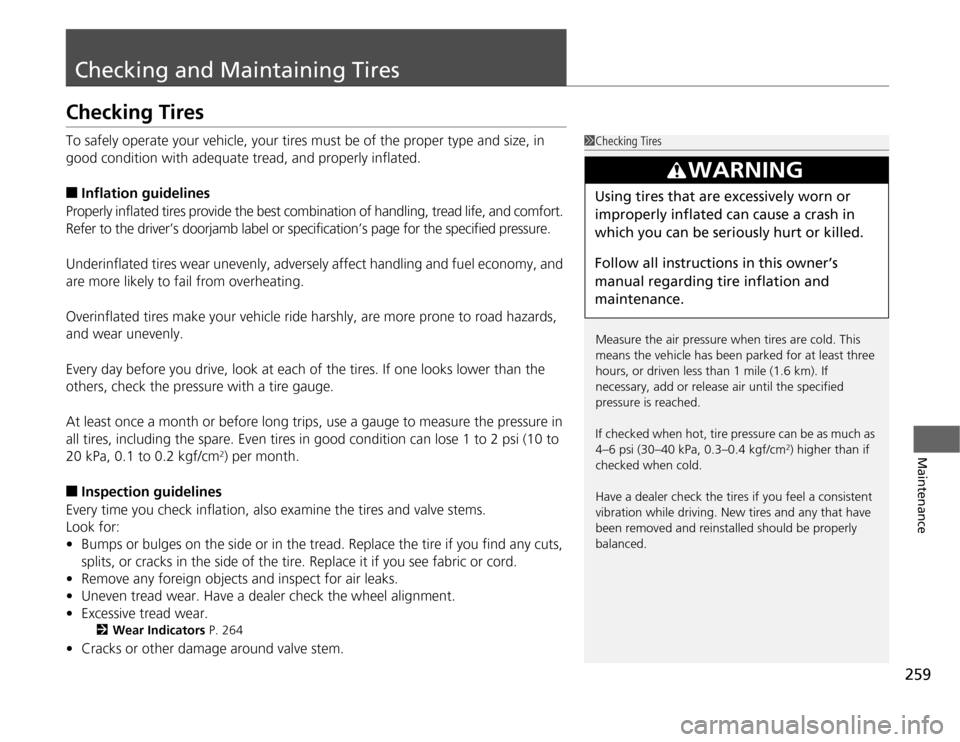
259
Maintenance
Checking and Maintaining TiresChecking TiresTo safely operate your vehicle, your tires must be of the proper type and size, in
good condition with adequate tread, and properly inflated.■
Inflation guidelines
Properly inflated tires provide the best combination of handling, tread life, and comfort.
Refer to the driver’s doorjamb label or specification’s page for the specified pressure.
Underinflated tires wear unevenly, adversely affect handling and fuel economy, and
are more likely to fail from overheating.
Overinflated tires make your vehicle ride harshly, are more prone to road hazards,
and wear unevenly.
Every day before you drive, look at each of the tires. If one looks lower than the
others, check the pressure with a tire gauge.
At least once a month or before long trips, use a gauge to measure the pressure in
all tires, including the spare. Even tires in good condition can lose 1 to 2 psi (10 to
20 kPa, 0.1 to 0.2 kgf/cm
2) per month.
■
Inspection guidelines
Every time you check inflation, also examine the tires and valve stems.
Look for:
•Bumps or bulges on the side or in the tread. Replace the tire if you find any cuts,
splits, or cracks in the side of the tire. Replace it if you see fabric or cord.
•Remove any foreign objects and inspect for air leaks.
•Uneven tread wear. Have a dealer check the wheel alignment.
•Excessive tread wear.
2Wear Indicators P. 264
•Cracks or other damage around valve stem.
1Checking Tires
Measure the air pressure when tires are cold. This
means the vehicle has been parked for at least three
hours, or driven less than 1 mile (1.6 km). If
necessary, add or release air until the specified
pressure is reached.
If checked when hot, tire pressure can be as much as
4–6 psi (30–40 kPa, 0.3–0.4 kgf/cm
2) higher than if
checked when cold.
Have a dealer check the tires if you feel a consistent
vibration while driving. New tires and any that have
been removed and reinstalled should be properly
balanced.
3
WARNING
Using tires that are excessively worn or
improperly inflated can cause a crash in
which you can be seriously hurt or killed.
Follow all instructions in this owner’s
manual regarding tire inflation and
maintenance.
Page 276 of 324

275
Handling the Unexpected
This chapter explains how to handle unexpected troubles.
Tools.................................................. 276
Types of Tools .................................. 276
If a Tire Goes Flat.............................. 277
Changing a Flat Tire ......................... 277
Engine Does Not Start
Checking the Engine ........................ 283
Jump Starting.................................... 284
Shift Lever Does Not Move.............. 287
Overheating...................................... 288
How to Handle Overheating ............. 288Indicator, Coming On/Blinking
If the Low Oil Pressure Indicator Comes
On.................................................. 290If the Charging System Indicator Comes
On ................................................. 290
If the Malfunction Indicator Lamp Comes
On or Blinks ................................... 291If the Brake System Indicator Comes On .. 292If the EPS Indicator Comes On.......... 292
If the Low Tire Pressure/TPMS Indicator
Comes On or Blinks........................ 293Fuses
Fuse Locations ................................. 294
Circuit Protected and Amps for Each
Fuse............................................ 296Inspecting and Changing Fuses ........ 298
Emergency Towing........................... 299
When You Cannot Unlock the Fuel Fill
Door................................................. 300
When You Cannot Open the Trunk.. 301
Page 284 of 324
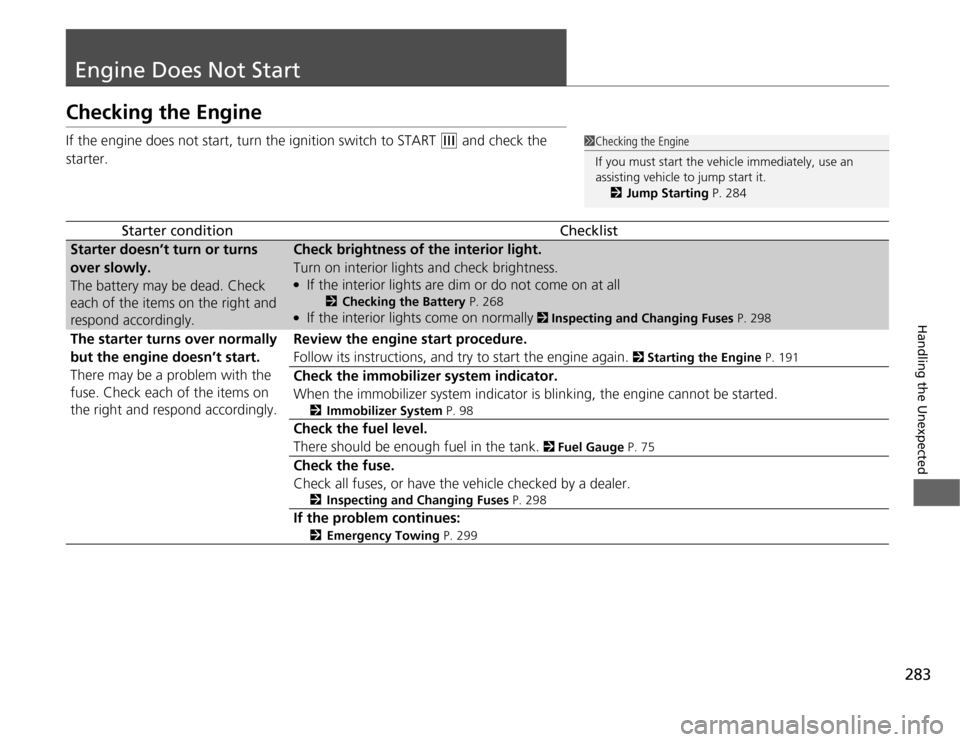
283
Handling the Unexpected
Engine Does Not StartChecking the EngineIf the engine does not start, turn the ignition switch to START
(e
and check the
starter.
Starter condition
Checklist
Starter doesn’t turn or turns
over slowly.
The battery may be dead. Check
each of the items on the right and
respond accordingly.
Check brightness of the interior light.
Turn on interior lights and check brightness.●
If the interior lights are dim or do not come on at all
2Checking the Battery P. 268
●
If the interior lights come on normally
2 Inspecting and Changing Fuses P. 298
The starter turns over normally
but the engine doesn’t start.
There may be a problem with the
fuse. Check each of the items on
the right and respond accordingly.
Review the engine start procedure.
Follow its instructions, and try to start the engine again.
2 Starting the Engine P. 191
Check the immobilizer system indicator.
When the immobilizer system indicator is blinking, the engine cannot be started.
2Immobilizer System P. 98
Check the fuel level.
There should be enough fuel in the tank.
2 Fuel Gauge P. 75
Check the fuse.
Check all fuses, or have the vehicle checked by a dealer.
2Inspecting and Changing Fuses P. 298
If the problem continues:
2Emergency Towing P. 299
1Checking the Engine
If you must start the vehicle immediately, use an
assisting vehicle to jump start it.
2Jump Starting P. 284
Page 292 of 324
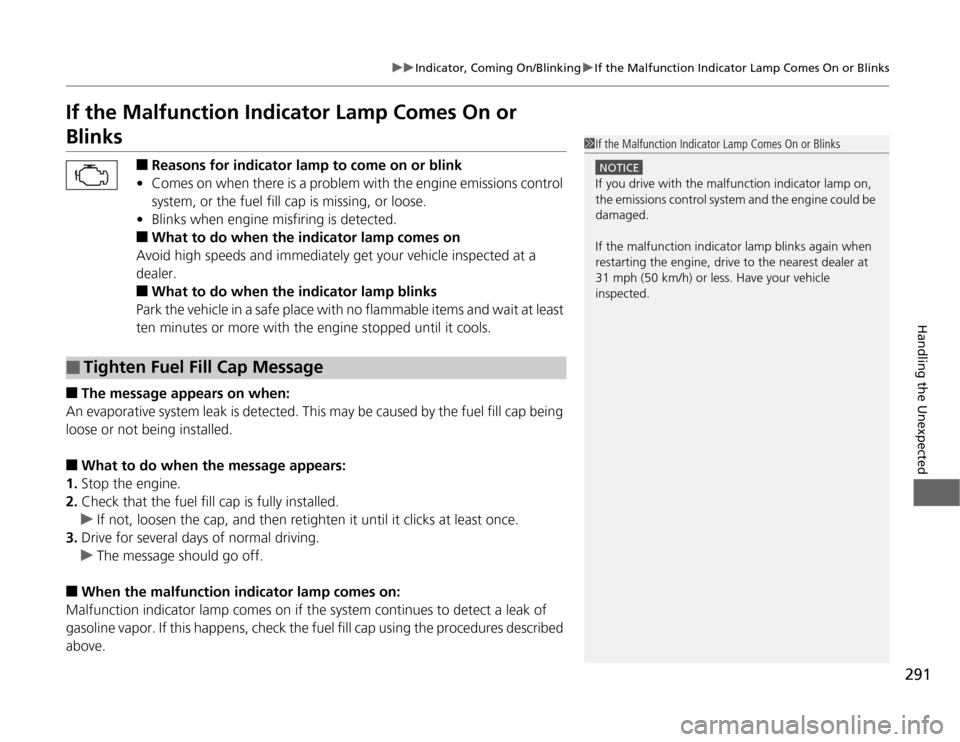
291
uuIndicator, Coming On/BlinkinguIf the Malfunction Indicator Lamp Comes On or Blinks
Handling the Unexpected
If the Malfunction Indicator Lamp Comes On or Blinks
■
Reasons for indicator lamp to come on or blink
•Comes on when there is a problem with the engine emissions control
system, or the fuel fill cap is missing, or loose.
•Blinks when engine misfiring is detected.
■
What to do when the indicator lamp comes on
Avoid high speeds and immediately get your vehicle inspected at a
dealer.
■
What to do when the indicator lamp blinks
Park the vehicle in a safe place with no flammable items and wait at least
ten minutes or more with the engine stopped until it cools.
■
The message appears on when:
An evaporative system leak is detected. This may be caused by the fuel fill cap being
loose or not being installed.
■
What to do when the message appears:
1.Stop the engine.
2.Check that the fuel fill cap is fully installed.
uIf not, loosen the cap, and then retighten it until it clicks at least once.
3.Drive for several days of normal driving.
uThe message should go off.
■
When the malfunction indicator lamp comes on:
Malfunction indicator lamp comes on if the system continues to detect a leak of
gasoline vapor. If this happens, check the fuel fill cap using the procedures described
above.
■
Tighten Fuel Fill Cap Message
1If the Malfunction Indicator Lamp Comes On or Blinks
NOTICEIf you drive with the malfunction indicator lamp on,
the emissions control system and the engine could be
damaged.
If the malfunction indicator lamp blinks again when
restarting the engine, drive to the nearest dealer at
31 mph (50 km/h) or less. Have your vehicle
inspected.
Page 297 of 324
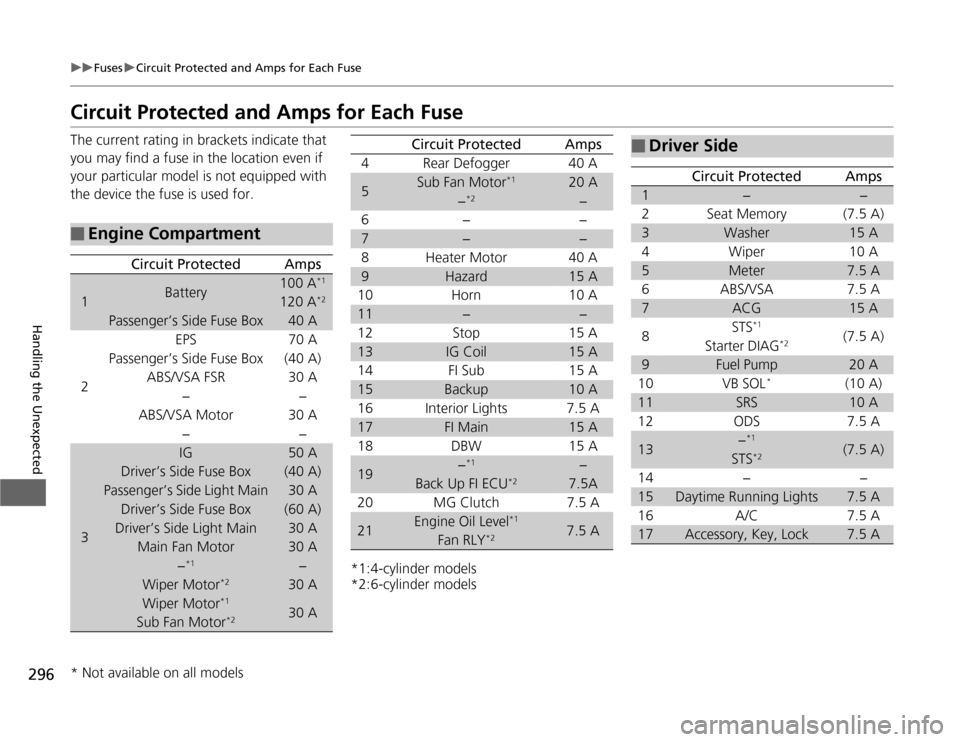
296
uuFusesuCircuit Protected and Amps for Each Fuse
Handling the Unexpected
Circuit Protected and Amps for Each FuseThe current rating in brackets indicate that
you may find a fuse in the location even if
your particular model is not equipped with
the device the fuse is used for.■
Engine Compartment
Circuit Protected
Amps
1
Battery
100 A
*1
120 A
*2
Passenger’s Side Fuse Box
40 A
2
EPS
70 A
Passenger’s Side Fuse Box (40 A)
ABS/VSA FSR
30 A
−−
ABS/VSA Motor
30 A
−−
3
IG
50 A
Driver’s Side Fuse Box
(40 A)
Passenger’s Side Light Main
30 A
Driver’s Side Fuse Box
(60 A)
Driver’s Side Light Main
30 A
Main Fan Motor
30 A
−*1
−
Wiper Motor
*2
30 A
Wiper Motor
*1
30 A
Sub Fan Motor
*2
*1:4-cylinder models
*2:6-cylinder models4 Rear Defogger 40 A5
Sub Fan Motor
*1
20 A
−*2
−
6− −
7
−
−
8 Heater Motor 40 A
9
Hazard
15 A
10 Horn 10 A
11
−
−
12 Stop 15 A
13
IG Coil
15 A
14 FI Sub 15 A
15
Backup
10 A
16 Interior Lights 7.5 A
17
FI Main
15 A
18 DBW 15 A
19
−*1
−
Back Up FI ECU
*2
7.5A
20 MG Clutch 7.5 A
21
Engine Oil Level
*1
7.5 A
Fan RLY
*2
Circuit Protected
Amps
■
Driver Side
Circuit Protected
Amps
1
−
−
2
Seat Memory
(7.5 A)
3
Washer
15 A
4
Wiper
10 A
5
Meter
7.5 A
6
ABS/VSA
7.5 A
7
ACG
15 A
8
STS
*1
(7.5 A)
Starter DIAG
*2
9
Fuel Pump
20 A
10
VB SOL
*
(10 A)
11
SRS
10 A
12
ODS
7.5 A
13
−*1
(7.5 A)
STS
*2
14
−
−
15
Daytime Running Lights
7.5 A
16
A/C
7.5 A
17
Accessory, Key, Lock
7.5 A
* Not available on all models
Page 301 of 324
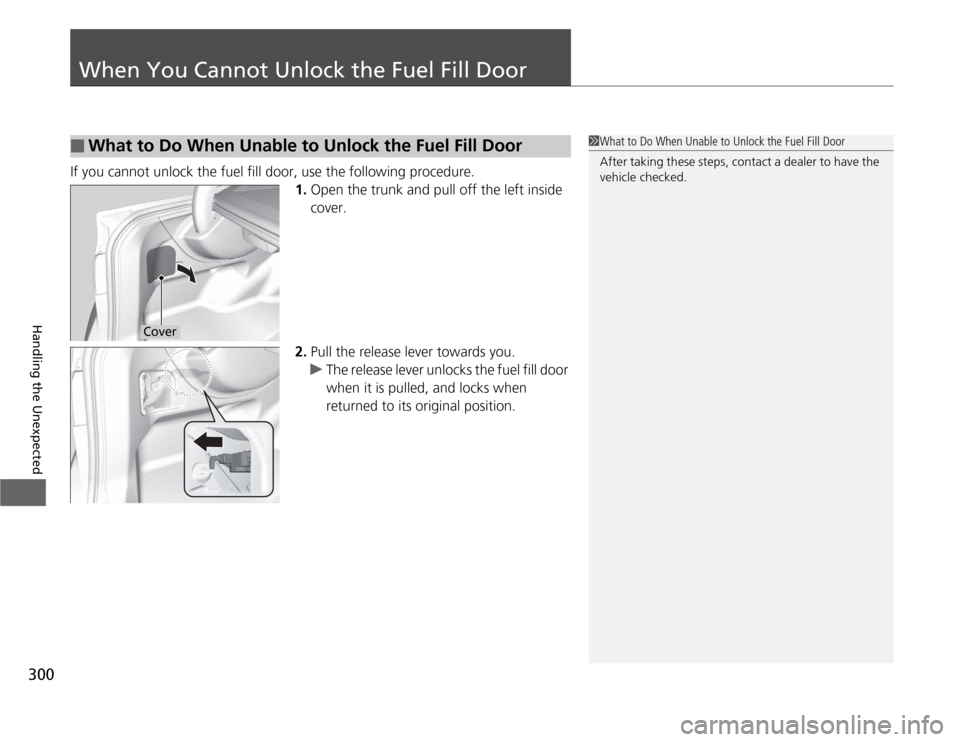
300Handling the Unexpected
When You Cannot Unlock the Fuel Fill DoorIf you cannot unlock the fuel fill door, use the following procedure.
1.Open the trunk and pull off the left inside
cover.
2.Pull the release lever towards you.
uThe release lever unlocks the fuel fill door
when it is pulled, and locks when
returned to its original position.■
What to Do When Unable to Unlock the Fuel Fill Door
1What to Do When Unable to Unlock the Fuel Fill Door
After taking these steps, contact a dealer to have the
vehicle checked.
Cover
Page 305 of 324
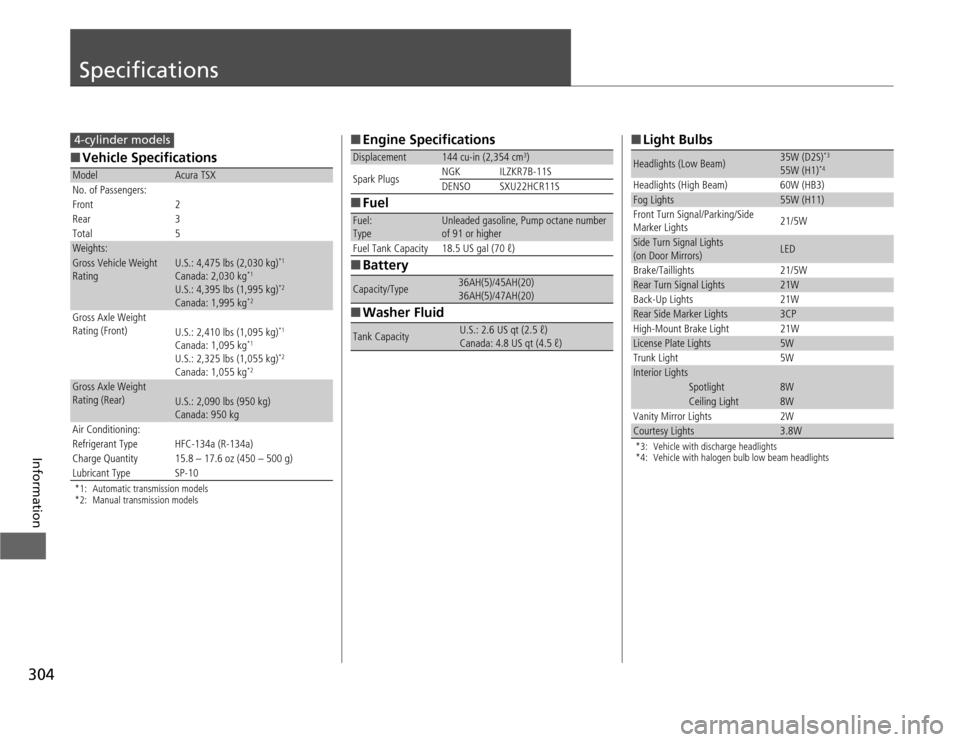
304Information
Specifications■Vehicle Specifications*1: Automatic transmission models
*2: Manual transmission modelsModel
Acura TSX
No. of Passengers:
Front 2
Rear 3
Total 5
Weights:Gross Vehicle Weight
Rating
U.S.: 4,475 lbs (2,030 kg)
*1
Canada: 2,030 kg
*1
U.S.: 4,395 lbs (1,995 kg)
*2
Canada: 1,995 kg
*2
Gross Axle Weight
Rating (Front)
U.S.: 2,410 lbs (1,095 kg)
*1
Canada: 1,095 kg
*1
U.S.: 2,325 lbs (1,055 kg)
*2
Canada: 1,055 kg
*2
Gross Axle Weight
Rating (Rear)
U.S.: 2,090 lbs (950 kg)
Canada: 950 kg
Air Conditioning:
Refrigerant Type HFC-134a (R-134a)
Charge Quantity 15.8 – 17.6 oz (450 – 500 g)
Lubricant Type SP-10
4-cylinder models
■Engine Specifications
■Fuel
■Battery
■Washer FluidDisplacement
144 cu-in (2,354 cm
3)
Spark PlugsNGK ILZKR7B-11S
DENSO SXU22HCR11S
Fuel:
Type
Unleaded gasoline, Pump octane number
of 91 or higher
Fuel Tank Capacity 18.5 US gal (70 ℓ)
Capacity/Type
36AH(5)/45AH(20)
36AH(5)/47AH(20)
Tank Capacity
U.S.: 2.6 US qt (2.5 ℓ)
Canada: 4.8 US qt (4.5 ℓ)
■Light Bulbs*3: Vehicle with discharge headlights
*4: Vehicle with halogen bulb low beam headlightsHeadlights (Low Beam)
35W (D2S)
*3
55W (H1)
*4
Headlights (High Beam) 60W (HB3)Fog Lights
55W (H11)
Front Turn Signal/Parking/Side
Marker Lights21/5W
Side Turn Signal Lights
(on Door Mirrors)
LED
Brake/Taillights 21/5W
Rear Turn Signal Lights
21W
Back-Up Lights 21W
Rear Side Marker Lights
3CP
High-Mount Brake Light 21W
License Plate Lights
5W
Trunk Light 5W
Interior Lights
Spotlight
8W
Ceiling Light
8W
Vanity Mirror Lights 2W
Courtesy Lights
3.8W